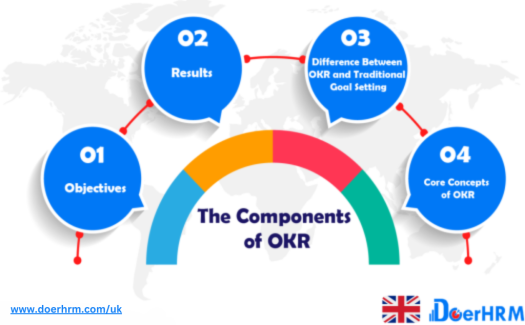The term OKR stands for “Objectives and Key Results,” representing a widely embraced management approach to structure and guide teams toward their objectives. A team without a clear and precisely outlined plan may struggle to accomplish tasks effectively, and this is precisely where OKR proves valuable. When the OKR strategy is appropriately applied, it unites teams, aligning their efforts toward a common goal
The Components of OKR

Taking into consideration its name, the components of OKR are quite simple. There are two components, and you use them as follows:

1. Objectives
This component of OKR has you defining three to five important objectives for your company, team, or your personal tasks. These objectives should be qualitative, ambitious, bound by time, but also easy to put into motion by every person (and every team). These objectives will keep you focused on your tasks so that you do not lose sight of the following component:
2. Results
With every objective, you should define around three to five key results that can be easily measured. These results must be easily achievable and lead towards the grading of an objective. It should also be difficult – but it shouldn’t be impossible to achieve.
The results of an OKR strategy should be based on performance, growth, but also engagements – regardless of which one fits your team the most. Most of the time, they are numerical, but they may also show whether something is done or not (i.e. binary 0r or 1).
3. Difference Between OKR and Traditional Goal Setting
To learn how OKRs can help take your team to the next level, enroll in our OKR Mastery course and earn a 35% commission when you invite others to join this course!
OKRs are quite similar to traditional goal setting, which might have you wondering if there is any difference between them. The difference is there, but it is quite small.
Traditional goal setting has you focusing on the objectives of a management strategy. The problem here is that you know you have to reach your goals – but you won’t actually know how to get there.
With OKRs, your traditional goals are split into those two concepts: the objectives and the key results. The objective part will answer the question of where you wish to go, whereas the key results will take you through how you will get there. This way, you will have a clear picture painted in front of you.
4. Core Concepts of OKR
OKR strategies offer simple and clear frameworks for setting your goals. When you prepare an OKR, your target is quite clear right ahead of you. In the end, a company or team using this type of strategy might be able to measure its own progress by using the core concepts of OKR.
- Agility
A shorter goal cycle provided by an OKR will allow for a much quicker and efficient adaptation in terms of changes. It will also increase the rate of innovation while reducing waste and risks, making it a much more agile way to tackle the situation.
- Simplicity
The OKR use is fairly straight forward and OKRs are very easy to understand on their own. For example, the model set by Intel will feature goals every month – which is a very light weight process.
By adopting the OKR strategy, companies will be reducing their time spent on their goals. Instead of spending months on setting them, those goals will only take days. In the end, the remaining time and resources will be uses on achieving those objectives.
- Transparency
The main thing that the OKR does is to take the organization and create some sort of alignment for it. In an attempt to do so, the OKRs are made public for every level of the company. Any person can access the OKRs of another person, as long as they are within the same company.
Plus, while some OKRs are only available for the entire company, others can be made for everyone to see. For instance, the OKRs of the CEO are usually searchable on the internet for any other person to see – employee or not.
- Nested Rhythm
When it comes to OKR, you need to understand that tactics nd strategies have different tempos. Tactics have the tendency of changing at a much quicker rate, which is why OKRs use different rhythms to resolve this issue:
The more these nested rhythms are followed, the easier it will be for teams and companies to implement an OKR strategy.
- Strategic high-level rhythm, with OKRs set in the long term – in most cases, on an annual basis.
- A tactical rhythm that features a shorter-term OKR that the team may be guided by – in most cases, on a quarterly basis.
- Operational rhythm for keeping score of the initiatives and the results – usually done every week.
- Bidirectional Goal Setting
Rather than using the classic top-down cascading model that doesn’t add as much value and only takes time to implement, OKRs employ a market-based approach. This means that it includes top-down and bottom-up at the same time.
- Ambitious Goals
OKR philosophy says that if there’s a 100% chance of reaching your goals, then they are too easy. For this reason, goals must be ambitious and bold, so that each team member may work at their top performance level.
- Decoupling
If you want to enable ambitious and bold goals, then you have to separate the OKR from promotions and compensation. Every employee has the right to know that they won’t be losing their daily or monthly income if the goals they set are rather ambitious.
Common OKR Mistakes
OKR implementations can contain quite a few mistakes. The most popular ones are the following:
- Setting key results that cannot be measured. Each key result needs to be measured in some way.
- Setting the OKR in a top-down method. OKRs don’t function on a cascading pattern.
- Implementing too many key results or OKRs. Bear in mind that the OKR isn’t a list of every little detail that you will have to do. Instead, it represents your top priorities
- Tasks are set as key results. The key result is not something that you do. Instead, it is the outcome of the things that you did.
- Setting up the OKRs within silos. When setting their OKRs, teams should be able to talk to each other. If they can’t, it might be quite difficult for them to obtain alignment
- Losing track of the nested rhythm. OKRs aren’t “set and forget,” like your new year’s resolution. They will have to be tracked at a regular pace so that success can be achieved. As long as it is used correctly, OKR can be a very useful management tool.
Good OKRs Writing Guidelines
If you want to set good OKRs, here are some writing guidelines that you may want to keep in mind:
Objectives have to be short, simple, and very easy to memorize. If you feel the need to take a breath while you are going through an objective, then you’re clearly doing something wrong.
The objectives should be far from boring – they must be as interesting as possible. No matter if you use slang, jokes, or whatever suits your culture, make sure they are entertaining enough to be remembered.
Set only a few key results. You should not set more than 2-5 per objective.
Tasks must be separated from metrics.
The Bottom Line
Utilizing OKRs is a highly effective means of maintaining organization within your team and company. When implemented with clarity and simplicity, they tend to outperform traditional goal-setting methods. This approach should lead to swift and tangible results.









